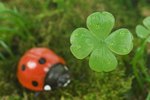
Animals may not be able to speak in master language techniques, but they're certainly able to communicate with one another; their survival depends on it. Animals generally communicate using four methods: visual, auditory, tactile and chemical. Some species rely more on one form of communication over another; however, they all various methods to show affection, ward off threats or attract a mate.
Visual Communication

Visual communication for animals comes in two forms: badges and displays. Badges, the color and shape of the animal, are structural adaptations, such as the bright yellow feathers of the male American goldfinch. The bright colors tell a prospective mate that the male is a suitable choice. Displays are the behaviors animals exhibit, such as the glow of a firefly to attract mates or when a dog wags his tail to let you know he's happy.
Visual communication is the least effective since the animals must be close enough to see one another.
Auditory Communication

Barking, growling, hissing and purring all are considered animal auditory communication. Sounds can be used to attract mates, ward off threats and express happiness or pain.
For example, dogs bark when approached by a stranger. Red squirrels use a series of rattles, screeches and yips to warn intruders to stay away. And dolphins use auditory communication to set themselves apart from others -- a unique whistle that also helps them locate food.
Tactile Communication

Like humans, animals can rely on tactile communication -- touch -- to convey messages. Most animals use this form of communication to show affection, comfort or fear, or even to establish dominance. For instance, horses will kick each other to ward off threats or when competing for a mate. As kittens, cats will nuzzle their mothers to show affection. Many species of primates will clean each other to bond and show affection.
Chemical Communication

For some species of animals, communication is about pheromones or chemical markings. They will leave their own scents to mark their territories, ward off predators or attract a mate. The most well-known example is that of skunks "spraying" their signature scents when threatened. Cats will rub against objects to make their territories, leaving scent markers from their mouths.
References
Photo Credits
-
Lynn_Bystrom/iStock/Getty Images
Writer Bio
Crystal Owens is the managing editor at a Northern Virginia newspaper with more than 10 years experience in journalism. She has worked as a reporter in Florida, Pennsylvania, South Carolina and Georgia, covering various topics from crime to politics to health care. She studied communications at the University of North Florida.



